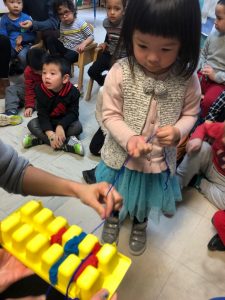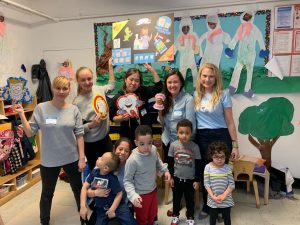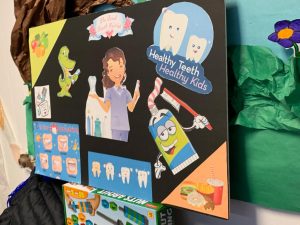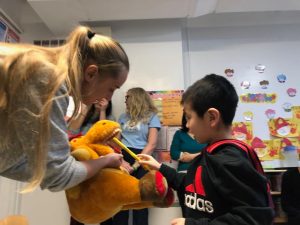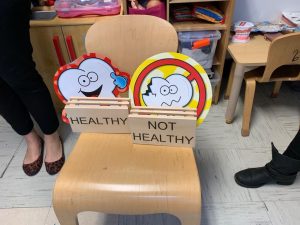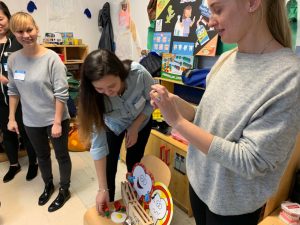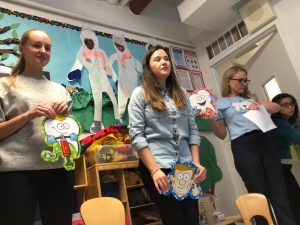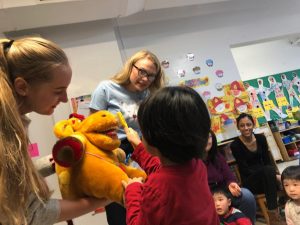For our Service Learning Field Project activity, our group decided to target developmentally disabled children under 6 years old. These children are less likely to receive preventive dental care than those who are school-aged. We chose to develop an oral hygiene education program for the children at the East River Child Development Center. This center offers educational and therapeutic services for children between the ages of 2 and 5 as authorized by the local school district CPSE.
The first part of our oral hygiene education lesson was the introduction. Instead of introducing ourselves as “dental hygiene students” we used the term “tooth fairies” so that the students would make an easier association. We asked the children basic questions about teeth to engage and motivate them to be involved. While asking questions such as “Does anyone know what this is?” we would hold up a cartoon tooth picture cutout or refer to our poster board of pictures.
To make the transition from the introduction to the first learning activity, we introduced the concept of “playing some games.” The purpose of this was to create positive-association towards the activity. Since the first learning activity was about tooth brushing, the children were then asked some general questions such as “Does anyone know how long we are supposed to brush our teeth for?” The questions ensured that we had the students’ attention before giving directions. Since children with disabilities do not always make eye contact, even when they are paying attention, we looked for other signs such as alert posture, orientation towards us, stopping other activities and verbalizations. We demonstrated to the children how to brush in circular strokes, first brushing the outsides of the teeth and then the insides and the tops. Then the children practiced by “helping” Dudley the Dinosaur learn how to brush. The materials used were typodonts, the dinosaur puppet and large plastic toothbrushes.
The second learning activity was geared towards flossing. The children were told that flossing goes along with brushing and that it is important to remove germs from between the teeth. The children then practiced on a row of “teeth” (plastic ice cube trays) filled with “bacteria” (play dough) and 18-inch lengths of “floss” (yarn). We showed the children how to guide the floss gently between the “teeth,” pulling it up, down and around to clean both sides of the teeth and the gum area.
The last learning activity revolved around nutrition. We talked to the children briefly about sugary foods and how they can be harmful to the teeth. Then we showed them how to identify foods that can cause cavities and tooth decay. Part of this activity was to play the “food sorting game” in which the children could choose food and decide if it goes in the “healthy” or “unhealthy” category. Instead of using the words “healthy” and “unhealthy,” we described certain foods as making teeth happy and others that make teeth sad. Materials used were plastic play “foods” and two boxes labeled “healthy” and “unhealthy.” Two “tooth” cartoon cutouts of “happy” and “sad” teeth were placed directly above the boxes so that the children could determine the difference.
Early intervention programs such as the one implemented with our oral hygiene education lesson provide an excellent opportunity to engage children with special needs. These children are at high risk for poor oral health and services for them are usually limited and only delivered in response to a problem. Because of this, it is very necessary to identify effective ways to improve coordination or oral health-related activities across community-based organizations such as the East River Child Development Center. In developing and modifying future programs, it would be very helpful to gain insight from the parents, dentists and medical providers as to how to improve the delivery of oral health care education and services to children with special needs.
The current population has a greater need for oral healthcare because children with disabilities are much more likely to survive into adulthood than they would in previous decades. That is why it is so important to educate these children and their caregiver(s) about good oral hygiene habits early on.

